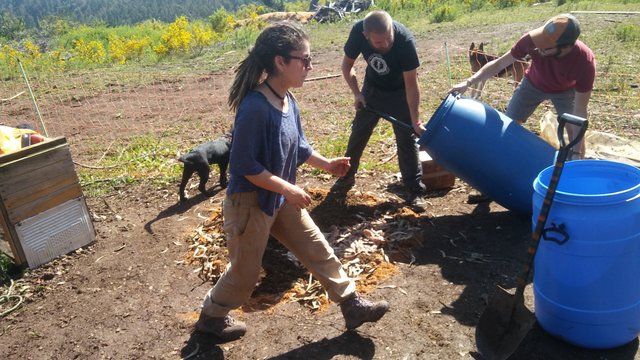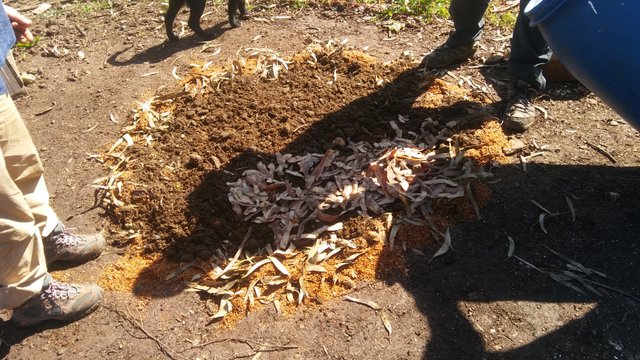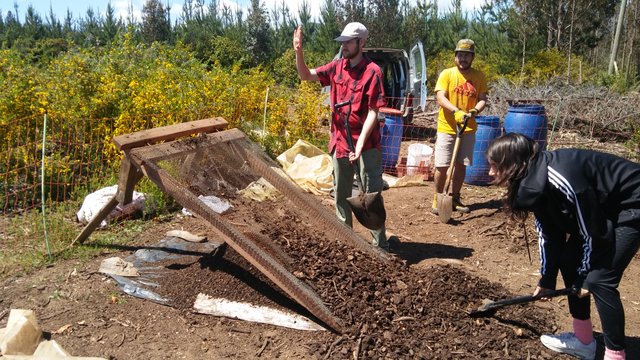Permaculture - advanced composting (lesson 4) + mini contest
Intro
As a person who loves permaculture and learns about it for years, I have decided to share with you all my knowledge gained during the volunteers on many farms from Poland and Spain to Chile and Paraguay and during my theoretical studies. Lessons will be published regularly, I share it totally for free of CC-0 license (which means you can copy my text and share it wherever you want to, without the need to mark me as an author). I hope it will bring you joy
Lesson 1- manure and liquid manure
Lesson 2 - types of manure and when to use it
Lesson 3 - Compost. Basics
Advanced composting
When creating an ideal compost, we try to match the ingredients so that the weight ratio of carbon to nitrogen (C: N) is as close to 30 as possible
Here, the averaged C: N ratio of some of the most used components:
| component | C:N ratio |
|---|---|
| urine | 0.8 |
| blood | 3 |
| fish scraps | 4 |
| chicken manure | 7 |
| human feces | 8 |
| humus | 10 |
| hair and fur | 10 |
| vegetable waste | 11 |
| kitchen waste mixed | 12 |
| Coffee grounds | 14 |
| grass | 15 |
| algae | 19 |
| apple peelings | 20 |
| Fresh weeds | 20 |
| Fruit waste | 25 |
| cattle manure with straw | 20-25 |
| Horse manure | 25 |
| Ash | 25 |
| fresh leaves | 30 |
| nutshells | 35 |
| oat straw | 48 |
| dry leaves | 50 |
| corn cobs and stalks | 60 |
| paper | 100 |
| wheat straw | 130 |
| sawdust 3 years old | 200 |
| cardboard | 350 |
| sawdust fresh | 500 |
| Branches | 700 |
Example:
As we remember from our previous lesson, compost should have three layers: first up to 45% with sawdust, branches, and leaves, second minimum 45% with organic leftovers, and then we cover it with 10% of humid soil.
To count perfect C:N ratio, we will skip the soil which is there only to stimulate some heating processes and protect the compost from drying too fast (if you use hummus instead of regular soil, you can include it in counting and it will lower your C:N ratio a bit).
To get 100 kg of the perfect compost we can use 10 kg of soil (not included in counting ratio), 45 kg of the first layer made by 35 kg of fresh leaves (C:N 30), 5 kg of old sawdust (C:N 200), and 5 kg of ash (C:N 25).
We have to count the weighted average. We are multiplying the ratio per amount of the ingredient, summarizing everything, and later dividing it by the total weight which is 45:
[(35x30) + (5x200) +(25x5)] : 45 = 48.3
Now, it's just the ratio of the lower layer so don't worry that it's high. We will easily neutralize it with the second, organic layer. We add 45 kg of organic ingredients: It will include 30 kg of kitchen leftovers (all the fruits, veggies left after the meals, peels, eggshells, etc) with C:N 12, 10 kg of chicken manure (C:N 7), and 5 kg of fish scraps (C:N 4)
Weighted average of that part is:
[(30x12) + (10x7)+(5x4)]:45 = 10
Total C:N ratio will include all the ingredients from both layers:
[(35x30) + (5x200) + (25x5) + (30x12) + (10x7)+(5x4)] : 90 = 29.15
The result so close to 30 is very satisfying and may guarantee that the fertilizer will be high quality.
COMPOSITE PLACEMENT:
The first time you start your adventure with permaculture, it is a good idea to oxidize the soil a bit and distribute the compost as follows:
- loosening the soil with a rotary tiller or pitchfork
- spreading the compost evenly over the entire surface
- using the tiller or forks once again
- If you use compost before planting the plants, you can start planting after about two weeks
Each subsequent time we make compost as the top layer, you can slightly move the soil with a pitchfork (with time, while maintaining the principles of permaculture, this action will be unnecessary), but do not carry out plowing with a rotary tiller.
It is best to apply the compost each year just before sowing the main crop, or a week or two before if the animal manure was used for production (then not for every vegetable; see the manure lesson for more information).
Extreme fertilization:
It's in use only for the most devastated soil.
Maximum layer 1.5 cm thick. In addition, you can apply a layer of max. 0.5 cm before each forecrop / catch crop with a total cultivation period of more than 4 months, which gives a result of approx. 25 kg / 1m2 before the main crop and additionally approx. 8 kg for longer crops / catch crops.
Intensive fertilization:
Compost feeding at the rate of 10 kg / 1m2 per year, 20 kg / 1m2 every two years, or 40 kg / 1m3 every four years
Standard fertilization:
the usual dose in gardens is 2.5-3 kg / 1m2
ATTENTION!
Many countries have legal regulations regarding the maximum amount of fertilizers that can be fed to arable land, including sometimes a reference to natural compost (although properly prepared compost without manure cannot be overdosed anyway). Although no one will check what doses of fertilizers we use in our private garden, it is worth familiarizing yourself with the regulations and, if possible, adapt to them.
I realize that permaculture is not the mainstream hobby and many people may not be interested in reading posts related to that subject. For those of you who read it, I have the hidden contest. Answer in the comment one question I will ask you below to get the chance to gain a small reward. The best answer will get 5 STEEM. The contest lasts until the next lesson is published, so approximately 2 days.
- Prepare the recipe for 100 kg of the perfect compost which includes at least 5 ingredients. Count the C:N ratio of it.
Thank you for reading,
@papi.mati


